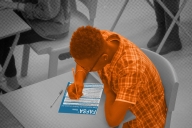You have /5 articles left.
Sign up for a free account or log in.
The Consumer Financial Protection Bureau has announced a series of amendments to its July report on private student loans, including two statistics the bureau now says were incorrect.
The report, which called for increased regulation on private student loans, including asking Congress to consider allowing borrowers to discharge those loans during bankruptcy, understated the proportion of student borrowers who hadn't exhausted their federal loan options. Since some students did not take out federal loans at all, and in some cases did not apply for federal financial aid, 55 percent — not 40 percent — of private student loan borrowers did not first exhaust their eligibility for federal loans, which have more flexible repayment options than most private loans.
But the report also overstated how many loans were made without college involvement. From 2005 to 2007, the proportion of loans made without a college's involvement or consent grew from 18 percent to more than 31 percent, the agency said. It had reported earlier that as many as 70 percent of loans were made without college certification.
That correction was the result of an updated methodology developed with industry experts and sample student lenders, the agency said. The previous number had not counted loans if the lender did not provide specify in what program (undergraduate, graduate, medical, law, and similar classifications) the borrower was enrolled, meaning many undergraduate loans were missed, the agency said in its report. The new methodology used proxies (such as "course of study" or "year in school") from the data to determine the program type.
The agency said the corrections do not affect the report's conclusions. "While the frequency of [direct-to-consumer] borrowing is lower than the Agencies had previously concluded, the risk of consumer harm related to DTC lending programs is unchanged from the original analysis," the consumer protection bureau wrote in its report on the changes.








